Contents |
Non-Poisonous Weeds and Recommended Grass and Legume Pasture Species
Authored by: Krishona Martinson, PhD; Roger Becker, PhD; Lynn Hovda DVM, MS; Mike Murphy, DVM, PhD.
The following information is taken from excerpts from the original publication made possible by the University of Minnesota. The full version of this publication is available for purchase online. For more information on this publication, or to purchase the publication, please visit the University of Minnesota Extension Store.
Introduction
Pasture weed control is a challenge for most horse owners. Considerable grass pasture acreage in Minnesota is infested with broadleaf and grassy weeds. Weeds are generally less palatable, less nutritious, less dependable and lower yielding than recommended species. Good grazing management, especially avoiding overgrazing, will reduce weed infestations. There are three types of weeds: annuals, biennials and perennials. Annuals complete their life cycle in one growing season. Biennials complete their life cycle in two growing seasons. Perennials normal live for three or more years. The objectives of this publication are to aid horse owners in identification of non-poisonous weeds and desirable pasture species commonly found in established Minnesota horse pastures and to offer weed control options. Information on poisonous plants can be found in the University of Minnesota Extension publication Plants Poisonous or Harmful to Horses in the North Central United States (08491).
The key to management of any weed is to prevent its establishment with good pasture management, which includes overseeding thin areas, selecting appropriate forage species and maintaining soil pH and fertility. Once weeds are established, effective control requires a combination of mechanical, chemical and cultural methods. For annuals, mechanical weed control, such as mowing, is an effective method of control if done prior to the flowering and seed production. Using an herbicide to control annual weeds is most effective when applied in the spring to actively growing, small weeds. For biennials, mowing is not an option in the first year of growth because the rosettes are too close to the ground. Mowing is an effective control method in the second year as long as the mowing is complete before seed production. Chemical control of biennials is most effective when applied during the year’s growth. If treatment is delayed until the second year, an early season application of an herbicide before the flowers bloom is recommended.
Management of perennial weeds requires integrating cultural, mechanical and chemical control methods. Mowing alone may take several growing seasons to effectively control perennial weeds and may never result in complete control. Herbicides alone, or a single herbicide application, likely will not eradicate perennial weeds. Fall herbicide applications provide the most effective perennial weed control. Application of herbicides in the spring, or mowing during the summer, can be effective in controlling growth until fall. Apply herbicides selectively, carefully, and only if necessary. Always read and follow the herbicide label and comply with all grazing restrictions. Herbicides labeled for use in pastures are not harmful to horses when applied at the recommended usage rates and when all directions are carefully followed. Biological control, using host-specific natural enemies, has been successful on weeds like leafy spurge and purple loosestrife where traditional weed management methods are economically, logistically or environmentally undesirable.
If the pasture is a mixture of grasses and legumes like alfalfa or red clover, there are no herbicides that can be used to control broadleaf weeds selectively while not injuring or killing the legumes. Legumes can be seeded back in after weeds are controlled if a mixed pasture is the goal. Mowing and good pasture management should be used for a mixed pasture to avoid the need to use an herbicide. A well managed pasture will outcompete most weed species. Recommended pasture management includes avoiding overgrazing, testing soil pH and fertility every three years, fertilizing if needed and resting pasture for 30 days after grazing. Mowing, dragging and controlling weeds should be done during the rest period. More information on pasture management can be found in the University of Minnesota Extension publication Managing Established Horse Pastures (M08460).
Annual Broadleaf Weeds
Annual Broadleaf Weeds: Horseweed and Shepherd’s Purse
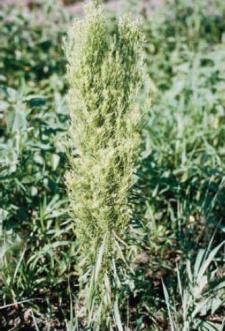

Species and Scientific Name: Horseweed (Conyza canadensis); Russian Thistle (Salsola kali); wild mustard (Brassica kaber); and shepherds purse (Capsella bursa-pastoris). Horseweed is also known as marestail. Russian Thistle is also known as tumbleweed.
Origin: Horseweed is native to the United States. Russian thistle, wild mustard, and shepherd’s purse are native to Europe and Asia (Eurasia).
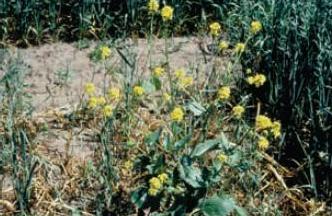
Distribution: Horseweed is common throughout the United States and Canada. Russian thistle is distributed mostly west of the Mississippi River. Wild mustard is common in the upper Midwest. Shepherd’s purse is common in the upper Midwest and northeastern United States.
Habitat: All are found in pastures, wastelands, croplands, and along roadsides.
Life Cycle: All are annuals. Wild mustard and shepherd’s purse are considered winter annuals.
Identification: Horseweed can reach a height of six feet and branches near the top. Beginning as a rosette, long, narrow, dark green leaves grow alternately along the stem. Leaves are whorled, giving it a bottlebrush appearance. Flowers are small and yellow. Russian thistle can reach a height of one to three feet. The stems are profusely branched and at maturity can resemble a shrub. The leaves are short, narrow, stiff and prickly. Wild mustard is a shorter stature plant, less than two feet, with bright green upper leaf surfaces. Leaves are toothed, alternate along the stems, and are often deeply lobed, especially toward the base of the plant. Flowers are small, with four petals, and yellow. Shepherd’s purse is pale green in color and can reach a height of 20 inches. Growing from a rosette, the first leaves have smooth margins, but later leaves are lobed. Flowers are small with four petals and white. The seed pods are heart shaped.
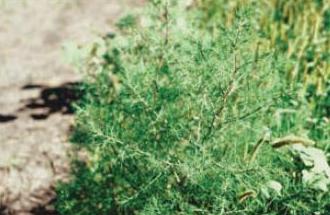
Control Options: Presence of annual weeds indicates a pasture with frequent disturbance and bare soil. Good pasture management that promotes consistent, complete ground cover of desirable forages will prevent annual weed establishment. A well managed pasture will outcompete most weed species. Avoid overgrazing and maintain soil pH and fertility or liming if needed. Plant forage species adapted for the soils and climate of your area. Rest the pasture for 30 days after grazing. Mow, drag, and control weeds during the resting period. If annual weeds have invaded, aggressively prevent new seed from being produced and accumulating in the soil seed bank. Several broadleaf herbicides offer some level of control for these annual broadleaf weeds. These herbicides could be should be applied in the spring when annual broadleaf weeds are less than six inches in height. For specific herbicide recommendations, see page 40.
Other information: Russian thistle is especially troublesome in dry years. The stems of Russian thistle break at the ground level and blow across open fields, scattering seeds along the way. Wild mustard and shepherd’s purse have a very short life cycle and can emerge and mature to produce seed within 30 days. Seeds of wild mustard and shepherd’s purse are toxic to horses.
Biennial Thistles
Species and Scientific Name: Bull thistle (Cirsium vulgare), musk thistle (Carduus nutans), and plumeless thistle (Carduus acanthoides). Musk thistle is also known as nodding thistle.
Origin: All are native to Europe and Asia (Eurasia).
Distribution: All are common throughout Minnesota and the northern United States.
Habitat: All are found in pastures, meadows, waste areas, and along roadsides.
Life cycle: All are biennials
Identification: Bull thistle grows to a height of two to five feet. Leaves are dark green, coarsely lobed and end in a long, sharp spine. The upper leaf surface is covered with short, stiff hair and spines, while the underside of the leaf is covered with dense, woolly, gray hair. Flowers are reddish-purple, are surrounded by spines, and narrow to a relatively tight constricted area. Musk thistle grows to a height of three to six feet. The leaves are bluish-green with light green midribs, a central vein in the leaf, and white margins that end in a white to yellowish spine. The leaves are coarsely lobed and slightly wavy. The leaves have little to no hair. Flowers are purple, surrounded by spines, and are often very large, making them droop. Plumeless thistle grows to a height of three to six feet tall. The leaves are narrow and deeply divided, with scattered hair on the upper surface and dense white hair in the lower surface. Lobes of the leaves end in a white to yellowish spine. Flowers are reddish-purple with spines.
Control options: Mowing is ineffective in the first year because the rosettes are tight to the ground. Mowing can be and effective control method in the second year, and should be completed between stem elongation and flower development. All mowing should be finished prior to seed production. Hand spading or cutting to remove flower stalks prevents seed production, breaks the life cycle and is an effective control method for small infestations. Control of biennials with herbicide is most effective if applied during the first year’s growth or in the early spring to the second year’s growth before the flower stalks elongate. For specific herbicide recommendations, see page 40.
Other information: These non-native thistles are Minnesota primary noxious weeds and by law must be controlled on all public and private land. Biological control has reduced the severity of musk thistle infestations in Minnesota. Native thistles are desirable. A thistle that remains scattered and occasionally present is likely one of the native Cirsium species such as tall, field, or Flodman’s thistle. These thistles do not require control, and offer desirable habitat for various finches and wildlife.
Biennial thistles: Bull Thistle


Biennial thistles: Musk Thistle
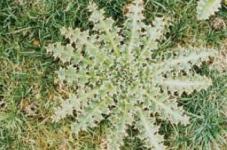

Biennial thistles: Bull Thistle
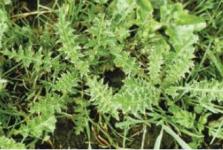

Common Milkweed
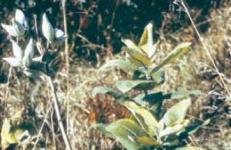
Scientific Name: Asclepias syriaca
Origin: Native to North America
Distribution: Common throughout the northern and eastern two-thirds of the United States and southern Canada.
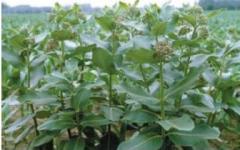
Habitat: Found in meadows, fencerows, waste areas, and reduced-tillage croplands, and along roadsides and railways.
Life cycle: Perennial.
Identification: Stems and leaves exude a white milky sap if cut or crushed. Purplish flowers form large, ball-shaped clusters. After seed pods mature, they release numerous tufted seeds.
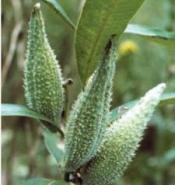
Control options: Mechanical control such as mowing, spading, or hand pulling is most effective in the late bud to early flower stage of growth. Mowing along may take several growing seasons to effectively control perennial weed populations, and may never result in complete control. Fall herbicide applications provide the most consistent control of perennial weeds. Multiple herbicide applications may be needed to completely control the extensive root system. Application of herbicides in spring or mowing during the summer is also effective in suppressing growth until fall. For specific herbicide recommendations, see page 40.
Other information: Monarch butterfly caterpillars feed on the foliage of common milkweed. Common milkweed is potentially poisonous to some livestock. However, most livestock will avoid ingesting it due to its bitter taste.
Chemical Control Table: Recommendations for Minnesota Grass Pastures
Download a PDF version of the Chemical Control Table
Grazing Restriction Table
When applying an herbicide, always read the herbicide label and follow all grazing restrictions. Prior to herbicide application, remove all animals from the pasture. Some herbicides may increase the palatability of weeds, including poisonous plants. If poisonous plants are present, restrict grazing for 10 days after herbicide applications. Labeled information presented below pertains to product labels for use in Minnesota only. Labels do change. Be sure to obtain and follow current labels as data in print publications can become outdated.
| Product name (active ingredient) | Grazing restrictions* | Harvest (haying) restriction** | Other information |
| 2,4-D & MCPA | 0 to 7 days | 30 days | Be sure to check individual product labels for restrictions and use rates due to the large number of formulations available. |
| Banvel (dicambia) | 0 | 0 | |
| Crossbow (triclopyr) | 0 | 0 | Areas of non-cropland and forestry sites may be grazed if no more than 10% of the total grazable area is spot treated. |
| Curtail (clopyralid + 2,4-D) | 0 | 7 days | Move animals to untreated grass pasture or feed untreated forage for 7 days before transferring livestock to broadleaf cropland or pastureland. See label for restrictions on manure applications from livestock fed herbicide treated forage and for mulch or compost applied to sensitive crops. |
| Escort (metsulfuron methyl) | 0 | 0 | |
| ForeFront (aminopyralid +2,4-D) | 0 | 7 days | Move animals to untreated grass pasture or feed untreated forage for 3 days before transferring livestock to broadleaf cropland or pastureland. See label for restrictions on manure applications from livestock fed herbicide treated forage and for mulch or compost applied to sensitive crops. |
| Grazon P+D (picloram + 2,4-D) | 0 | 30 days | Move animals to untreated grass pasture or feed untreated forage for 7 days before transferring livestock to broadleaf cropland or pastureland. See label for restrictions on manure applications from livestock fed herbicide treated forage and for mulch or compost applied to sensitive crops. |
| Milestone (aminopyralid) | 0 | 0 | Move animals to untreated grass pasture or feed untreated forage for 3 days before transferring livestock to broadleaf cropland or pastureland. See label for restrictions on manure applications from livestock fed herbicide treated forage and for mulch or compost applied to sensitive crops. |
| Overdrive (dicamba + diflufenzopyr) | 0 | 0 | |
| Redeem (clopyralid + triclopyr) | 0 | 14 days | Move animals to untreated grass pasture or feed untreated forage for 7 days before transferring livestock to broadleaf cropland or pastureland. |
| Remedy (triclopyr) | 0 | 14 days | Areas of non-cropland and forestry sites may be grazed if no more than 10% of the total grazable area is spot treated. |
| Roundup (glyphosate) | 14 days to 8 weeks | 14 days to 8 weeks | Be sure to check individual product labels for restrictions and use rates due to the large number of formulations available. |
| Spike (tebuthiuron) | 0 | 1 year | |
| Weed Master (2,4-D + dicambia) | 0 | 0 to 37 days |
*Days before grazing can resume after an herbicide application. When used as directed on the label, herbicides do not harm grazing animals. Even if the label lists no grazing restrictions for horses, seven days of restricted grazing after herbicide application can be followed as an additional precaution. Some weeds, including poisonous plants, may become more palatable after an herbicide application.
**Days before harvesting forage for hay after an herbicide application.


